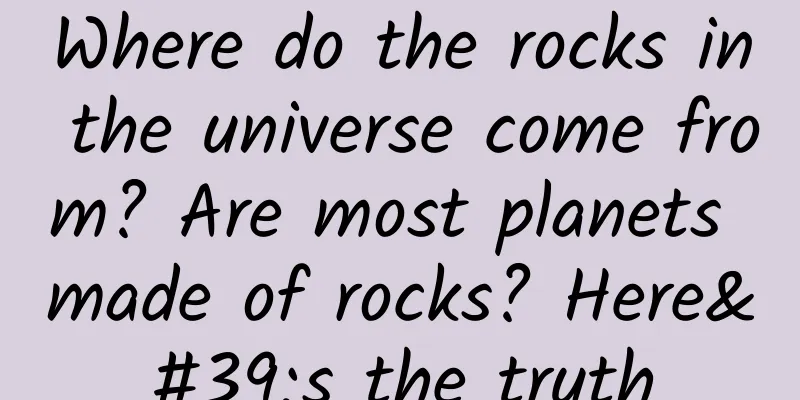Where do the rocks in the universe come from? Are most planets made of rocks? Here's the truth

|
This article is based on answering a question from netizens: The universe is so big, and most planets are made of stone. The question is, where do the stones come from? This question itself is a preconceived mistake. The universe is very large, so large that the scientific community still does not know how large it is. We only know that the radius of the observable universe is about 46.5 billion light years. But the conclusion that most planets in the universe are rocks is completely wrong. To clarify this issue, we need to first understand the process of the formation of the universe and the abundance of elements. Introduction to the origin of the universe and element abundance/ The standard cosmological model believes that the universe originated from a singularity explosion 13.82 billion years ago. The singularity is an infinitely small energy point. At the beginning of the explosion, the temperature was infinitely high and the density was infinitely large. However, within 1 second of the explosion, quarks, gluons, leptons, neutrons, protons, electrons and other particles were produced. Within 10 seconds of the explosion, protons and neutrons combined into atomic nuclei. Therefore, all matter in the universe is transformed from energy, which conforms to the mass-energy equation created by Einstein: E=MC^2. However, in the early days of the universe, the extremely high temperature, high pressure and high density prevented electromagnetic waves and light from escaping. The universe was in an opaque dark period, and electrons could not combine with atomic nuclei to form atoms. It was not until 380,000 years after the explosion, when the temperature of the universe dropped to 3000K and the density was greatly reduced, that photons were able to decouple and emit the first light since the birth of the universe, and electrons also combined with atomic nuclei to form neutral atoms. The elements of the universe started from the simplest. The earliest atoms were only hydrogen and helium, and a very small amount of lithium. These elements are ranked in the first three in the periodic table. There are only 1, 2, and 3 protons in the nucleus, and only 1, 2, and 3 electrons orbiting the nucleus. Their mass abundance (proportion) in the universe is: hydrogen accounts for 76%, helium accounts for 24%, and lithium is very small, accounting for about 0.00000006%. These data are certainly not made up at random. The answers have been obtained from measuring the afterglow left by the Big Bang. People call these afterglows cosmic microwave background radiation. This ubiquitous radiation is the remnant of the first ray of light emitted 380,000 years after the Big Bang. In the early days of the universe, these elements attracted each other under the influence of gravity and condensed into molecular clouds. These molecular clouds continued to gather, becoming larger and denser, and gradually formed stars and galaxies. Stars are the most important component of visible matter in the universe and exist in the form of plasma. Plasma accounts for more than 99% of visible matter in the universe. Therefore, the most abundant visible matter in the universe is plasma, not stone. The so-called visible matter is that modern astrophysics believes that of the total mass-energy of the universe, dark energy accounts for 68.3%, dark matter accounts for 26.8%, and visible matter, including stars, nebulae, photons, neutrinos, etc., only accounts for 4.9%. Dark energy and dark matter do not absorb or reflect light (electromagnetic waves), so we cannot see them. In the early universe, there were no other elements except hydrogen, helium and a small amount of lithium. As the nuclear fusion of stars continued to fuse light elements into heavy elements, the types of elements gradually increased. In the late stage of the evolution of massive stars, supernovas will occur, and under extremely high temperatures and pressures, heavier elements can be aggregated; major celestial events in the universe, such as neutron star collisions and white dwarf explosions, will form heavy elements, and eventually the 118 elements known today were formed. Although there are many types of elements in the universe now, the abundance of elements in the entire universe is still dominated by hydrogen and helium, which still accounts for 99%, and other heavy elements add up to only about 1%. The main elements that make up rocks are not hydrogen and helium, which is why planets in the universe cannot be dominated by rocks. How many rocky planets are there in the solar system? The solar system consists of a star, eight planets and many small celestial bodies. The sun is the only star in the solar system. It is a small or medium-mass star among the approximately 400 billion stars in the Milky Way. It is called a yellow dwarf, with a mass of about 1.989*10^30 kg, accounting for 99.86% of the total mass of the solar system. In other words, except for the sun, the other eight planets only account for 0.14% of the mass of the entire solar system, and smaller celestial bodies are basically negligible. Among the eight planets, there are 4 terrestrial planets and 4 Jovian planets. The terrestrial planets are close to the sun, and from the inside out they are Mercury, Venus, Earth, and Mars; the Jovian planets from near to far are Jupiter, Saturn, Uranus, and Neptune. The so-called terrestrial planets are planets with rocky shells like the Earth, also called rocky planets; Jovian planets are planets mainly composed of gas like Jupiter, also called gas giant planets. In fact, rocky planets are not all made up of rocks. For example, the oxygen content in the earth's crust is 46.6%; gas planets are not entirely made up of gas. For example, Jupiter and Saturn both have a small rocky core. Under high temperature and high pressure deep in the atmosphere, the gas also becomes liquid and metallic. But for the sake of convenience, we will count all rocky planets as rocks, and all gaseous planets as gases. So what proportion of the total mass of the eight planets is rock? The mass of the Earth is about 6*10^24 kg, the mass of Mercury is about 0.05 times that of the Earth, the mass of Venus is about 0.82 times that of the Earth, and the mass of Mars is about 0.11 times that of the Earth. The four terrestrial planets together are about 1.98 times the mass of the Earth. The gas giants are all giant planets. Jupiter accounts for more than 71% of the mass of the eight planets, which is about 318 times that of the Earth. Saturn is about 95 times the mass of the Earth, Uranus is about 14.6 times the mass of the Earth, and Neptune is about 17.2 times the mass of the Earth. In this way, the total mass of the four gas giants is 444.8 times that of the Earth. That is to say, the mass ratio of gaseous planets to rocky planets in the solar system is 444.8:1.98, and the mass of rocky planets only accounts for about 0.45% of the mass of all planets. The main compounds that make up rock are calcium carbonate or silicon dioxide. Calcium carbonate is composed of three elements: carbon, oxygen, and calcium, and silicon dioxide is composed of silicon and oxygen. How the rocks were formed The solar system contains all 118 elements in the universe, and the earth also contains all the elements in the universe. This shows that the solar system was not born from the original nebula of the Big Bang, but was born from the regeneration nebula left by the parent stars after experiencing at least one or even several supernova explosions, and also received the legacy of celestial events such as neutron star collisions. The abundance of elements in the solar system is approximately: hydrogen accounts for 73.46%, helium accounts for 24.85%, and other heavy elements account for about 1.69%, mainly oxygen 0.77%, carbon 0.29%, iron 0.16%, neon 0.12%, nitrogen 0.09%, silicon 0.07%, magnesium 0.05%, sulfur 0.04%, etc. The other 100 elements are even rarer. In the early stages of the formation of the Sun, the stellar wind was very strong, blowing the remaining dust and debris in the accretion disk far away. The heavy matter would be closer, and the light matter such as gas and water vapor would be blown farther away. Therefore, the terrestrial planets composed of heavy matter are close to the Sun, while the gaseous or icy planets composed of gas and ice are farther away from the Sun. The Earth is the largest of the four terrestrial planets in the solar system, but its mass is only 1/330,000 of that of the Sun. Of all the elements found on Earth, no element has been found in the universe that is not found on Earth. The elements with the highest abundance on Earth are: iron accounts for 32.1%, oxygen accounts for 30.1%, silicon accounts for 15.1%, magnesium accounts for 13.9%, sulfur accounts for 2.9%, nickel accounts for 1.8%, calcium accounts for 1.5%, and aluminum accounts for 1.4%. These eight elements account for 98.8% of the abundance of elements on Earth, and the remaining 1.2% is shared by the other 110 elements. When a planet is formed, it is formed by the collision of various debris. Like a snowball, it gets bigger and bigger. As its mass and volume increase, its gravity becomes stronger and stronger, and it attracts all the debris in the entire orbit. In the early stage of planet formation, due to the collision of small celestial bodies in its own orbit and the impact of a large number of meteorites, the entire planet is in a molten state. After the planet is formed, it slowly begins to cool, and a circle of rocks gradually forms on the surface, which is called the crust on Earth. Due to gravity and rotation, when the planet is molten, the heavier elements, such as iron and nickel, sink to the deeper part and the center of the earth. Therefore, the element abundance of the crust is different from that of the entire earth. The abundance of elements in the earth's crust calculated by scientific measurements is approximately: oxygen accounts for 46.6%, silicon accounts for 27.72%, aluminum accounts for 8.2%, iron accounts for 5%, calcium accounts for 3.63%, sodium accounts for 2.83%, potassium accounts for 2.59%, magnesium accounts for 2.09%, titanium accounts for 0.44%, hydrogen accounts for 0.14%, phosphorus accounts for 0.12%, manganese accounts for 0.10%, fluorine accounts for 0.08%, etc. The abundance of these 13 elements accounts for 99.54% of the 118 elements, and the remaining 105 elements can only share the remaining 0.46%. The so-called stone is a vague concept. In fact, it is rock fragments with complex composition. The rocks on the earth mainly include igneous rocks, granite, basalt, andesite, sandstone, quartzite, etc. The fragments of these rocks can be called stones. Their composition is mainly oxygen, silicon, calcium, etc., and also contains some other elements. The abundance of elements will vary depending on the place of origin. The asteroids floating in space are rocky and icy. Some are left over from the early days of the formation of the solar system, and some are broken and drifted in celestial body impacts. Their compositions are all the same as those of the solar system, but the contents of the various components are different due to different causes of formation. The formation and evolution of all star systems in the universe are roughly the same, so the origin of the stones in the solar system can also be regarded as the origin of the stones in the universe. This is the end of this question. If you have any questions, please leave a message in the comment area. Welcome to discuss, thank you for reading. The copyright of Space-Time Communication is original. Please do not infringe or plagiarize. Thank you for your understanding and cooperation. |
<<: Reminder! Don’t use the air conditioner like this in summer, it may cause blindness!
Recommend
What kind of marketing plan can be implemented?
My personal summary is that the marketing goals c...
On Double Eleven, how to deal with the dissatisfaction of old users after paid products are sold at a discount!
Double Eleven is here, and it’s time to shop. How...
Using the AARRR model to analyze community operations
"Is there a relatively comprehensive and sys...
Is it better to eat beef or pork? I didn't expect to have been eating the wrong one all along →
For meat lovers, pork and beef are probably indis...
What is the operating strategy for compliant cash loan products?
At this year's 315 Gala, 714 high-interest lo...
There are three basic routines for content creation. If you understand them, you can avoid taking 10 years of detours!
There was no trap in the world, but when more peo...
"Commercial Office∞|Haozu Xiaolou Product Upgrade Conference" was successfully held in Beijing
On November 18, Haozuo, a full value chain commer...
BlackBerry and Waterloo: The story of a company and a city
Waterloo is a small city in southern Ontario, Can...
2022 Latest Kaochong Wanci Winter Vacation Class
Introduction to the latest 2022 Kaochong Wanci wi...
Douyin Teacher Li's Mathematical Thinking Course (Grades 1-3)
Douyin Teacher Li's Mathematical Thinking Cou...
Brand Communication Perspectives for 2022
As long as it involves business, there will be ma...
In the future, can electric cars replace gasoline cars?
With the development of society and the advanceme...
Tutorial on how to edit mobile videos (Jianying) from scratch, a must-have skill in the era of short videos
Most of those who make short videos in self-media...
Case analysis of Toutiao information flow advertising
Based on our actual promotion situation, the effe...
Do you rely on "shivering" to keep warm in winter? 5 heater reviews to keep you warm in winter~
Winter in the north: witnessing the first snow vs...









